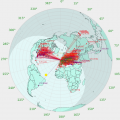Best Helpful Content
-
Audio timing walkabout [FT8 decoder problems solved with tighter limits on audio buffering]
So the problem here is that FT8 has a much greater time synchronization requirement (i.e. "wall clock" time) than WSPR does. The timing of the audio hitting FT8 must match what time the FT8 program is getting from the host operating system within a second or two at most.
The Kiwi produces a delay in the audio stream because it has some buffering. Buffering is required because it is the only defense against latency/interruption issues in the network, particularly when the audio is being delivered by the Internet over long distances with lots of potential points of interruption. So you are already being disadvantaged by the time delay of this buffering to begin with. Any additional cumulative delay by other software behaving badly (e.g. sample rate compensation by the VAC) may push the total timing over the FT8 limit.
One thing you could try is reducing the Kiwi buffer size to reduce the fixed delay. The penalty for doing this is that you will have much less immunity to short-term network interruptions. That means it's important to make sure there are no highly variable latency devices in the path between the Kiwi and computer running the browser, like a WiFi router or a cheap Ethernet switch that might behave badly with heavy traffic on the other ports.
Add "abuf=n.nn" to the URL where n.nn is a number in seconds of the minimum audio buffer size. Start with 0.5 and experiment with a range from 0.3 to 0.8
It would also be interesting to know on the control panel "Stats" tab what the value of the Audio "Qlen" (queue length) is when you are having problems versus what the value is when starting (this value will vary when the abuf= value is changed) -
30 min disconnection!?!?
@mdfrc99
Wow.
Thank you for illustrating the whole generational stereotype.
Very funny, made my morning.
OK here is the real answer:
These radios are things people have bought themselves, a few hundred dollars of investment initially, then add, buying and putting up antennas, sorting out noise issues even changing what we do around the house to help the radio perform well. Then we share them for people who are interested, want to listen to radio in another location, or who themselves cannot set up such a radio, we dont get anything back for that other than thinking that perhaps someone has benefited a little.
If the location is good, and the radio set up well then the limited number of slots is soon used up, its not like a streaming radio where numbers are almost unlimited its just a few users at any one time and each one takes up a chunk of our internet bandwidth. The way to allow everyone to get a little for testing is to limit connection time, 30 minutes is pretty extreme but you must be looking at a very popular Kiwi (mine is set at eight hours).
If you come to KiwiSDR with the wrong assumptions it does seem strange, if you realise these are real people trying to help each other for good will alone it may make sense, these are not streaming radio services. You may be able to find a less popular Kiwi that also picks up what you are looking to record they may have no time limit or a much longer one than 30 minutes. -
Preset HPF setting [fixed in v1.454]
v1.453,454 May 14, 2021
Added default passband adjustment to admin page, config tab.
As each passband parameter field is changed (low, high, center, width) the other
fields will be automatically adjusted. So if you know you want a USB filter
with a low frequency of 300 Hz that is 3300 Hz wide just enter those two fields
and the high and width values will be derived. An error message will appear if
you attempt to define an invalid passband.
The former "CW offset" field has been removed. To set your desired CW offset
simply set the default passband center frequency of the CW/CWN mode passbands
to the offset value. E.g. If you want to hear a 1000 Hz tone in the CW modes
set the passbands to have a 1000 HZ center.
After the passband is changed on the admin page, existing user connections will have
to reload the page to get the new passband values.
-
v1.456,458,459
-
30 min disconnection!?!?
-
pub0.kiwisdr.com & pub1.kiwisdr.com
These are from a recent attempt to make a "user preferences" function work. They are required by xdLocalStorage. I tried again about 6 months ago with xdLocalStorage. More recent browser security changes mean the scheme had to be changed once again compared to work that was done some years ago. It quickly got complicated, so I had to set the work aside for the moment.
For those that don't know, user preferences would be an extension that allows you, an ordinary Kiwi user (not owner/admin), to do things like: Setting the default cw passband set to 270 Hz and have that apply to every single Kiwi you ever visit from that point onward. Or the same with keyboard shortcut bindings. Or just about any other user interface customization that could be easily added.
That, plus a real mobile user interface, are the two major missing elements of the software (besides adding an extension to decode your favorite modulation waveform).
-
Flatness of KiwiSDR response < 500 kHz?
Phil,
Addressing your noise issues and not the spectral display, I would encourage you not to immediately jump to whack-a-mole in seeking to improve Kiwi Performance. Rather, I have found it very productive to examine the coupling mechanism rather than simply trying to stay on top of suppressing interference sources.
For electrically small structures, which almost everything at LF and below is, the radiation resistance is minuscule. For virtually all situations we encounter actual inverse-square radiation from any sources/antennas is far below the interference levels the Kiwi reports. Thus I think it worthwhile to look at near-field and, particularly common mode (CM) coupling mechanisms.
In my experience, the dominant undesired coupling mechanism into the Kiwi is CM current over the path between wired LAN connection and the SMA-end of the Kiwi PCB. This includes the BB ground plane, cape connections and ground plane current paths on the Kiwi PCB. If one uses an isolated source having low self-capacitance (and then perhaps further reduces the potential for CM with a low inter-turn capacitance 1:1 transformer to create a test current source), -10 dBm on 15 MHz injected between the BB RJ45 shell and the Kiwi Antenna SMA results in about -85 dBm displayed on the Kiwi. This is more than 70 dB above the Kiwi noise floor in 1 Hz. At 100 kHz it's only down another 22 dB or so, still far above what the Kiwi can easily detect. It's for this reason that for each of my four Kiwis at the home QTH I have gone to WiFi interface, BBG/Kiwi's as described elsewhere on this forum and BBAIs with their native WiFi interface.
At LF, the noise floor of interest will depend upon the antenna system. Broadband electrically small antennas (they all are at LF and below) have antenna factors rising at 20 dB/decade while the ITU propagated noise, though all over the map with diurnal and seasonal variations, generally falls at about 25 dB/decade of frequency. Thus the noise limit of interest may be quite a bit above the Kiwi's native floor of ~ -157 dB/1-Hz but it still may be well below the kinds of levels that CM current injected via the LAN, PS or even GPS lines might be able to produce within the Kiwi.
For the Kiwi, and really every receive system we use "ground isn't ground" except by definition. But care in examining coupling mechanisms, reducing current in CM paths and symmetry (passive and active baluns) can really pay off and gains made here tend to apply no matter what new SMPS or other noise source pops up in the environs.
As a proof-of-performance it's also very useful to use symmetric antenna structures rather than single ended ones, e.g. monopoles, because the intended antenna, e.g. dipole, can be shorted to observe and confirm that the residue CM is not significantly limiting system performance. Considering the many-10s of dB of symmetry/CM_rejection we may need broadband RF baluns really are insufficient over the 3-4 decades the Kiwi covers.
When CM has been removed, there can still be the issue of near-field coupling to deal with, but I digress...
Glenn n6gn
-
Camp Features
-
v1.446/445/444
From the CHANGE_LOG file. Not a lot new here. Except for days of tedious checking for memory errors (buffer overruns) and memory leaks to rule out a possible cause of the Windows 10 audio problems.
v1.446 March 28, 2021
WSPR extension:
By request: Added 6 & 13 MHz ISM bands (UK balloon-mobile operation).
Can restart autorun decoders via an admin page button instead of server restart.
Windows 10 audio "popping" problem:
Looked for memory addressing errors and leaks with the Clang address sanitizer.
A few minor issues fixed but nothing that changes the audio problem.
This was expected, but also had to be ruled out.
v1.445 March 24, 2021
SNR measurement:
Take transverter frequency offset into account.
Display SNR value(s) on user (top bar) and admin pages (status tab).
Added SAM PLL loop control to audio tab.
Has a slow loop setting "DX" that can be used to better track weak stations.
v1.444 March 23, 2021
Include two most recent SNR values in /status query. This implies all the SNR values
for public Kiwis will be aggregated in the rx.kiwisdr.com/index.html file
HTML comments.
TDoA extension:
Improved help panel contents.
Added warning against prematurely using too many sampling stations because of
the large number of computation timeouts we see on the server.
-
v1.437 From Marco, IS0KYB: AGC threshold bar, Passband overload mute
From the CHANGE_LOG file:
v1.437 March 6, 2021
From Marco, IS0KYB (thanks Marco!)
AGC threshold bar added to S-meter:
The white bar appearing above the green S-meter bar is the AGC threshold value
(from control panel AGC tab). The threshold dBm value can read on the
S-meter scale in equivalent S-units.
Passband overload mute:
Mutes the audio when the signal level in the passband exceeds a set value.
The value is defined by a new setting on the admin page config tab.
When active a "!" appears in place of the mute icon on main control panel.
Useful for example when a nearby transmitter would otherwise result in a
loud annoying signal. Mute recovery time uses existing squelch tail setting.
Added list of code contributors to _COPYRIGHT file.
Work in progress. If we missed your code contribution please email us.
We have hundreds of github issues and thousands of emails and forum posts to review.
Typing '/' alone into frequency box will restore the passband to the default value
for the current mode. Shortcut to shift-clicking over a mode button.
FFT extension: add help button, URL parameters, preset for RTZ.
Add mouseover popups to more buttons and menus on main control panel.
Removed more references to sdr.hu













